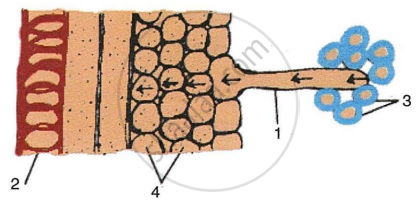Advertisements
Advertisements
Question
Differentiate between the following:
Plasmolysis and Deplasmolysis.
Solution
| Plasmolysis | Deplasmolysis | ||
| 1. | In this, the protoplasm of the cell shrinks away from the cell wall. It results in the flaccid condition of the cells and the plant. | 1. | In this, the protoplasm of the cell swells up and touches the cell wall. It results in the turgid condition of the cells and the plant. |
| 2. | Caused due to exosmosis. | 2. | Caused by endosmosis. |
| 3. | It takes place when a plant cell is kept in a hypertonic solution. | 3. | It takes place when a plasmolysed celI is kept in a hypotonic solution. |
| 4. | It results in the flaccid condition of the plant. | 4. | It results in the turgid condition of the plant. |
APPEARS IN
RELATED QUESTIONS
Give scientific reasons : Balsam plants wilt during mid-day even if the soil is well watered.
The diagram below represents a process in plants. The setup was placed in bright sunlight. Answer the following questions:

a) Name the physiological process depicted in the diagram.
Why was oil added to the water?
b) When placed in bright sunlight for four hours, what do you observe with regard to the initial and final weight of the plant? Give a suitable reason for your answer
c) What happens to the level of water when this setup is placed in:
- Humid conditions?
- Windy conditions?
d) Mention any three adaptations found in plants to overcome the process mentioned in (i).
e) Explain the term ‘Guttation’.
Differentiate between the following:
Turgor pressure and wall pressure
Give reason for the following:
It is better to transplant seedlings in a flower-bed in the evening and not in the morning.
Mention whether the following statement is true (T) or false (F) and give an explanation in support of your answer.
Soaked seeds burst into three seed coats.
Name the following:
The process by which wilting or drooping of leaves occurs.
Fill in the Blank
The condition opposite to turgid is ___________.
Fill in the Blank
Wilting and drooping of leaves is due to loss of ________.
Addition of salt to pickles is a method of killing the bacteria by ______.
The figure given below is a diagrammatic representation of a part of the cross-section of the root in the root hair zone. Study the same and then answer the questions that follow:

- The parts labelled as 1, 2, 3 and 4 are:
- Root hair, Xylem vessel, Soil particles, Cortex respectively.
- Xylem vessel, Soil particles, Root hair, Cortex respectively.
- Root hair, Xylem vessel, Cortex, Soil particles respectively.
- Cortex, Soil particles, Xylem vessel, Root hair respectively.
- The process that enables the passage of water from soil into the root hair is:
- Diffusion
- Active transport
- Osmosis
- Passive absorption
- The kind of force which exists between a liquid and any surface is called as:
- Cohesive force
- Adhesive force
- Capillarity
- Suction force
- The kind of force between the same kind of liquid molecules is:
- Capillary force
- Transpirational pull
- Adhesive force
- Cohesive force
- Sometimes exudation of water occurs from the margin of the leaves in the early morning or night. It is termed as:
- Transpiration
- Guttation
- Bleeding
- Osmosis
